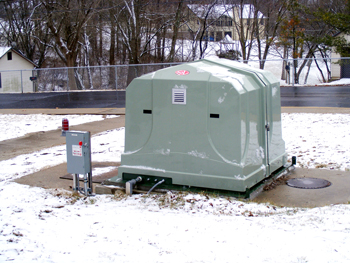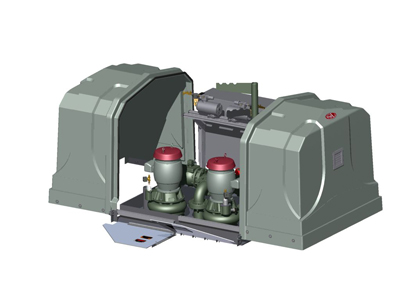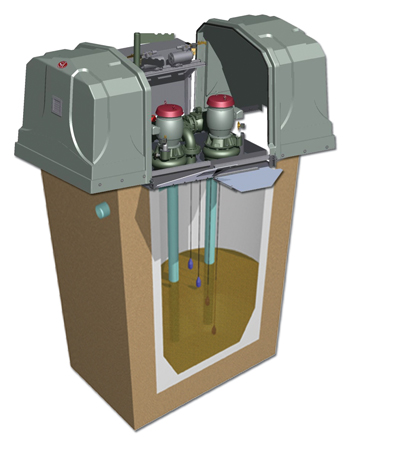Packaged wet well mounted pump station passes the test for school design-build sewer project.
Hazelwood West High School, nestled in north St. Louis County, Missouri, serves approximately 2,400 students with nearly 300 faculty and staff.
When the school first opened, it included an underground dry-pit pump station that conveyed sewage from its campus to the public sewer. The pump station consisted of a buried wet well connected to a buried pump vault with duplex, centrifugal pumps.
Occasional sewage back-ups from the aging station equipment led to a spring 2009 decision by school officials to replace the original station. Original specifications demonstrated pumping conditions of 400 gallons per minute at 60 feet total discharge head.
The Replacement Discussion
The school implemented a best value approach to the project and turned to local design-build firm Haberberger for its experience. Haberberger reviewed the condition of the existing station and began compiling three realistic technical options:
• Replace all the pumps and valves in the existing buried pit, along with the associated electrical and control work
• Abandon the dry pump pit and install submersible pumps nto the existing wet well
• Install a packaged wet well mounted pump station on top of the existing wet well
The school's staff provided thorough input when discussing which technical option offered the best long-term solution for the school district. Certain criteria emerged as important considerations during the design phase:
• A completion schedule that would ultimately meet the school's goal of having a new pump station in service before school resumed in August (from the previous spring)
• Energy conservation via the use of newer, more efficient sewage pumps
• Environmental sustainability
• Reduced operational and maintenance costs
• A guaranteed maximum price for the completed project that included all design, permitting, equipment, material and construction costs
• A solution with an aesthetically pleasing design—because the pump station is located at the rear corner of the school building and along a heavily traveled access road, the new
selected solution needed to look attractive while providing adequate security to protect the equipment from the weather and vandals
A Packaged Solution
Following the technical review process, the consensus selection was option three because the above-grade concept provided by wet well mounted pump stations demonstrated a more economical and safer approach for the school long-term. Haberberger specified a pump station manufacturer for the project.
By specifying a packaged pump station approach, Haberberger could now deal with a single- source throughout the entire project, from setting the initial project deadlines to the submittal phase for the manufacturing process to receiving the equipment for installation and start-up.
Additionally, the entire pump station would be assembled in a qualitycontrolled environment and be fully tested prior to shipment. This should minimize any troubleshooting or assembly problems in the field.
With a project window of a just couple of months, this would prove to be critical because the original station could not be taken off-line. The project required completion before fall classes commenced.
The arrangement of the school's new pump station differed significantly from the original underground chamber with flooded-suction pumps. The cornerstone of the wet well mounted pump station concept is vacuum-priming, which creates fluid suction-lift in order to prime the sewage handling pumps.
This becomes necessary because these vertically constructed, non-clog, vacuum-primed pumps reside at grade level above the confined space wet well and several feet about the liquid level. The suction-lift ensures pump priming for operation.
The vacuum-prime process has evolved today into a robust yet simple process that achieves priming in about 60 seconds from a non-primed condition, under standard rated conditions.
Three components—a pump prime sensor, a solenoid valve and a vacuum pump—make up the contemporary vacuum-priming process.
When the liquid level in the wet well requires the pump to start, the pump prime sensor determines whether the pump is primed. If priming is required, the vacuum pump commences and the solenoid valve (located on top of the visual inspection dome on the volute) opens. The vacuum pump evacuates air from the pump and the suction line in the wet well through half-inch diameter vacuum tubing. This causes the liquid to fill the pump volute and prime the pump.
When the prime sensor indicates that the pump is primed, the solenoid valve closes, the vacuum pump shuts off and the pump begins operating.
Once primed, the pump can remain primed for an indefinite period of time. Reliability is fundamental with this process, and its key naturally centers on the pump's prime sensor. This frequency modulation probe is not as prone to fouling as traditional electrodes despite the excessive grease and chemicals present in domestic sewage.
Maintenance Benefits
By selecting the vacuum-priming process, the design-build contractor and school facilitated greater safety for both the station installation sequence and long-term operation.
During installation, requirements for entering the existing wet well would be severely reduced compared to the options of rehabilitation and installing submersible pumps, each of which would require extensive wet well entry.
Long term, the school's maintenance staff would no longer be subject to entering a confined space underground nor be required to access the wet well to maintain equipment. Instead, all the pumping equipment, valves and controls are immediately accessible without requiring special safety gear and harnesses.
Not only does this eliminate routine confined space hassles, but it also reduces maintenance time and cost.
The school will now have the ability to perform virtually all pump maintenance and repairs on site, if desired, without the use of outside contractors or expensive pump maintenance centers.
The entire rotating assembly is simplified. Removing only eight cap screws from the connecting motor adapter to the volute facilitates full access to the volute and suction elbow.
Maintenance and operations costs contribute significantly to the accumulation of life cycle costs, which was an important factor in the decision process.
The process review demonstrated a typical pump service life of greater than 20 years, four to five times longer than submersible options.
Additionally, higher wire-to-water efficiencies at the design point will save annually on electrical costs. Their vertical construction with exclusive traits such as oversized stainless steel pump shafts, oversized bearings, bronze seal housing, premium efficient motors with Class F insulation and trimmed impellers inside the shrouds comprise a durable finish made for the ongoing, day-to-day business of pumping sewage.
Project Completion and Success
All parties moved quickly to get the project completed before school started in August.
While the pump station was being fabricated, Haberberger was busy completing a review of the flow data and conducting on-site work at the pump station site in preparation of the new pump station's arrival.
It was determined during this phase that the original pump conditions on record in the school's office were not matching with actual conditions.
After a series of pump cycle tests, the design conditions were altered to 756 gallons per minute at 81 feet total discharge head. This necessitated a pump change, but the manufacturer handled this issue prior to testing and shipment without any interruption to the final schedule.
Therefore when the new pump station arrived on site, everything was ready so that it could be immediately installed.
The new pump station was set in place. The piping connections were made, and electrical connections were completed. Municipal Equipment Co.'s local start-up technician was present immediately thereafter to test the new station and perform operation and maintenance training for the school personnel.
In summary, the new wet well mounted pump station was in-place and running satisfactorily before the first day of school.
The school district obtained a safer and more efficient pump station that will yield cost savings for decades. It's been operating for approximately a year, and the school's maintenance staff is pleased with its reliable performance and easy access.
Maintenance staff can perform all inspections and maintenance at grade level without any confined space restrictions. “The process offered innovation, cost benefits and energy efficiency to the project,” says Don Kettenbach of the Hazlewood School District. “The (pump station) that was installed is easy to maintain, aesthetically acceptable as well as compact and adapted well to the existing piping system.”
On Nov. 19, 2010, the Design-Build Institute of America's Mid- America Section recognized the Hazelwood West School pump station project at its annual Design-Build Awards Competition in Kansas City as an outstanding water/wastewater design build project in the Midwest.
Pumps & Systems, March 2011




